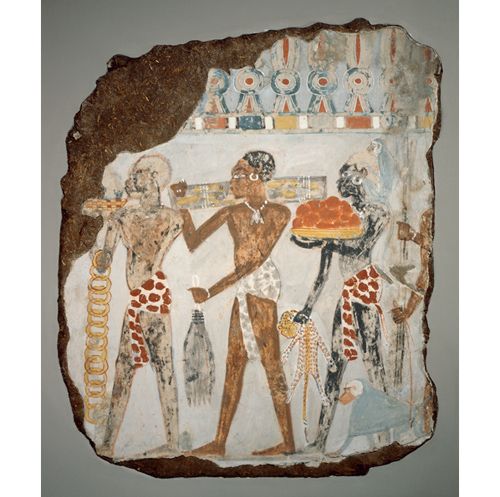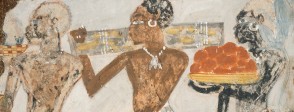
Ancient diplomacy
This painting comes from the tomb of Sebekhotep, a treasury official in the service of the Egyptian king Thutmose IV. One of Sebekhotep’s duties was to receive gifts sent to the king from overseas, and this painting was part of a larger scene depicting foreign trade missions bringing tribute. It shows three men from Nubia (present-day Sudan) carrying luxury items: gold rings, logs of ebony, giraffe tails, red jasper and a leopard skins as well as a live monkey and baboon.
In the ancient world, leaders of nations communicated by sending envoys to each other’s courts. As seen here, etiquette required exchanges of gifts as a sign of good faith and mutual respect. Letters were sent via messengers carrying ‘passports’ that gave them diplomatic protection. Since there was often no common language, discussions and correspondence usually required interpreters and translators.
The trading network
As early as 5000 BC, the first Egyptians were trading tools, weapons, hunting equipment and ornaments with the Levant to the north (the lands bordering the eastern coast of the Mediterranean Sea), Mesopotamia (present-day Iraq) to the east and Nubia to the south. Important ideas and technologies like writing, glassmaking and the use of horses and chariots were introduced to Egypt through contact with their neighbours.
The Nile provided everything the Egyptians needed for their daily lives, but it was trade that made Egypt rich and powerful. The river Nile, overland routes and access to the Mediterranean Sea and the Red Sea meant that Egypt became the chief trading route between Africa, Asia and Europe in the ancient world. Taxation on the goods that passed through Egypt brought wealth to the state. As well as exporting home-produced goods like grain, linen and papyrus, the Egyptians controlled the trade in African goods such as those in the painting, as well as incense, ivory, feathers and ostrich eggs. These were exchanged for commodities Egypt could not produce: silver from Syria, olive oil from Crete and wood from Lebanon.
From about 2500 BC, the Egyptian government organized large-scale trading expeditions to distant lands. These were carried out by the army and trading parties were often away for years. The traders normally travelled by boat, along the Mediterranean and Red Sea coasts and up the Nile. Overland routes through the deserts also played an important part in Egypt’s trading network. Caravans with goods loaded on donkeys or carried by porters travelled south to Nubia, west to the desert oases and Libya, east to Sinai and the Red Sea and north to the Levant.
The growth of an empire
As time went on, the Egyptians found that the best way to protect their trading interests was to become actively involved in the affairs of neighbouring lands. A priority was to maintain control over the gold mines of Nubia. The Nubians were fierce warriors, but they were not as powerful as the Egyptians who occupied their lands, building forts from where army garrisons controlled mining and trading operations.
Gold from Nubia was mainly traded with the Levant. This region was divided into small city-states. The fact that no single state was strong enough to threaten Egyptian territory was an advantage for Egypt, but the constant fighting between rival kingdoms often disrupted trade, leading to Egyptian military intervention. However, rather than attempting to rule these lands directly, as they did in Nubia, the Egyptians gave the rulers of city-states gold and the protection of the Egyptian army if they were loyal and obedient to the pharaoh. This had two advantages: the region was made safe for Egyptian traders and its territories provided a zone of protection between Egypt and powerful enemies such as the Hittites and Assyrians.
On the whole, this strategy worked well, and at the height of its power, the Egyptian empire stretched all the way from the borders of modern Turkey in the north to the fourth Nile cataract in present-day Sudan. However, it was a constant struggle for Egypt to maintain control of its territories, and lands were always being gained and lost. If trade was affected badly, lost revenues meant Egypt could not afford troops to defend its borders and foreign powers were able to invade. At various times, Egypt was ruled by, among others, Nubians (about 747 – 656 BC), Assyrians (669 – 525 BC), Persians (525 to 404 BC and 341 to 332 BC) and Greeks (conquered by Alexander the Great in 332 BC), until in 30 BC it finally became a province of the Roman empire.
More information
Egyptian foreign relations
With links to translations of diplomatic letters.
http://www.reshafim.org.il/ad/egypt/law_and_order/international_law.htm
Diplomatic correspondence
Diplomatic correspondence between the Egyptian court and the rulers of Middle Eastern countries, with translations of letters.
http://www.ancientegyptonline.co.uk/amarnaletters.html
Diplomatic letter
Diplomatic letter from the Babylonian king Burnaburiash to the pharaoh Amenhotep IV.
http://www.britishmuseum.org/explore/highlights/highlight_objects/me/l/clay_tablet_letter,_egypt.aspx
Ancient Egyptian overseas trade
Article on ancient Egyptian overseas trade, with useful links.
http://www.reshafim.org.il/ad/egypt/trade/
Hatshepsut’s trading mission to Punt
The story of Hatshepsut’s trading mission to Punt (present-day Somalia).
http://www.touregypt.net/featurestories/punt.htm
Blue glass jar of Thutmose III
Glassmaking was probably introduced to Egypt by craftsmen brought back as prisoners following Thutmose’s campaigns in Syria.
http://www.britishmuseum.org/explore/highlights/highlight_objects/aes/b/blue_glass_jug,_inscribed.aspx
Egyptian warfare
Useful article on Egyptian warfare, with information on weapons and army structure, and many additional links to related topics.
http://www.touregypt.net/featurestories/war.htm
Egypt’s border with Kush
Page on Egypt’s border with Kush (upper Nubia), with pictures of forts and translations of royal inscriptions and security reports.
http://www.specialtyinterests.net/journey_to_nubia.html
Brief overview of ancient Sudan
http://www.britishmuseum.org/explore/cultures/africa/ancient_sudan.aspx
More information
-
Egyptian foreign relations
With links to translations of diplomatic letters.
Source: reshafim.org.il
-
Diplomatic correspondence
Diplomatic correspondence between the Egyptian court and the rulers of Middle Eastern countries, with translations of letters.
Source: ancientegyptonline.co.uk
-
Diplomatic letter
Diplomatic letter from the Babylonian king Burnaburiash to the pharaoh Amenhotep IV.
Source: britishmuseum.org
-
Ancient Egyptian overseas trade
Article on ancient Egyptian overseas trade, with useful links.
Source: reshafim.org.il
-
Hatshepsut’s trading mission to Punt
The story of Hatshepsut’s trading mission to Punt (present-day Somalia).
Source: touregypt.net
-
Blue glass jar of Thutmose III
Glassmaking was probably introduced to Egypt by craftsmen brought back as prisoners following Thutmose’s campaigns in Syria.
Source: britishmuseum.org
-
Egyptian warfare
Useful article on Egyptian warfare, with information on weapons and army structure, and many additional links to related topics.
Source: touregypt.net
-
Egypt’s border with Kush
Page on Egypt’s border with Kush (upper Nubia), with pictures of forts and translations of royal inscriptions and security reports.
Source: specialtyinterests.net
-
Brief overview of ancient Sudan
Source: britishmuseum.org


